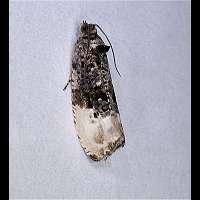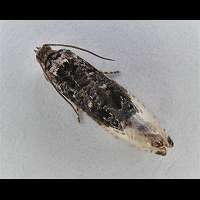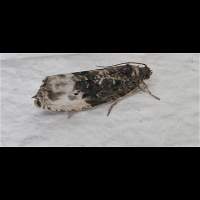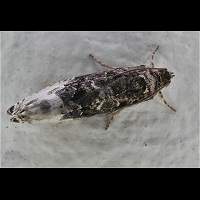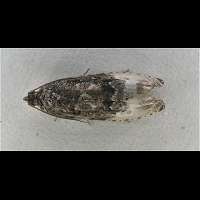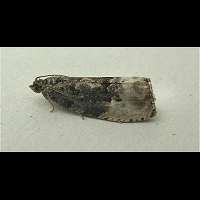Marbled Orchard Tortrix Hedya nubiferana
This Tortrix Moth is extremely difficult to identify. It looks like other Hedya species very much indeed. Compared to the Long-cloaked Marble the dark parts of the wing are blueish rather than brownish. The white parts are really white and not creamish at all. Alas, there is another common species: the Plum Tortrix (Hedya pruniana). It too looks very similar, but usually has a very dark spot in the tip of the forewing. And there are other similar species too. Even experts often have a hard time identifying these species. And even size doesn't mean a lot, for they all start at some 15 mm wingspan. The Marbled Orchard Tortrix and the Long-cloaked Marble will both be some 23 mm tops. The Plum Tortrix usually doesn't reach a bigger wingspan than some 18 mm.
The eggs are laid separately or in small groups, usually on the underside of a leaf. They hatch quickly, normally within a fortnight, but sometimes in just one week. During the first week of its life, the caterpillar of the Marbled Orchard Tortrix is light brown. It looks terribly bald and even slightly transparant. After casting this initial skin the caterpillar turns a glazy dark green. It has blackish spots all over the body and a black, saddle like spot just behind the head. The head itself is darkbrown or black. It is hard to tell it apart from other Tortrix larvae. The caterpillars may be found from June onwards. For a small moth like this, the caterpillars are rather big, for full-grown they'll reach some 18 to 25 mm. Young caterpillars, measuring some 7 mm only, overwinter in a light cocoon, which is spun near the fork of branches or in the bark of the tree. In early spring they will leave their shelter and penetrate a young bud. They spin together a couple of small leaves and start feeding again. This is the time they do most damage to various fruit trees. Later in the year the newly emerged larvae might nibble on almost full grown fruit superficially. As such there is almost no damage done, but the fruit gets very perceptible to fungi and diseases. The Marbled Orchard Tortrix may become a plague in apples, pears and prunes. They are hard to fight though, as they also use common hostplants in the wild, such as Hawthorn and Rowan (or Moutain Ash).
The Marbled Orchard Tortrix is on the wing from the end of May to the beginning of September. It flies from dusk onwards and is easily attracted to light. During daytime it rests on the top of leaves of trees and shrubs. Most abundant of all Hedya species and common all over the British Isles.
Scientifically also known as Hedya dimidioalba. The caterpillar is also known as the Green Budworm.
This Tortrix Moth is extremely difficult to identify. It looks like other Hedya species very much indeed. Compared to the Long-cloaked Marble the dark parts of the wing are blueish rather than brownish. The white parts are really white and not creamish at all. Alas, there is another common species: the Plum Tortrix (Hedya pruniana). It too looks very similar, but usually has a very dark spot in the tip of the forewing. And there are other similar species too. Even experts often have a hard time identifying these species. And even size doesn't mean a lot, for they all start at some 15 mm wingspan. The Marbled Orchard Tortrix and the Long-cloaked Marble will both be some 23 mm tops. The Plum Tortrix usually doesn't reach a bigger wingspan than some 18 mm.
The eggs are laid separately or in small groups, usually on the underside of a leaf. They hatch quickly, normally within a fortnight, but sometimes in just one week. During the first week of its life, the caterpillar of the Marbled Orchard Tortrix is light brown. It looks terribly bald and even slightly transparant. After casting this initial skin the caterpillar turns a glazy dark green. It has blackish spots all over the body and a black, saddle like spot just behind the head. The head itself is darkbrown or black. It is hard to tell it apart from other Tortrix larvae. The caterpillars may be found from June onwards. For a small moth like this, the caterpillars are rather big, for full-grown they'll reach some 18 to 25 mm. Young caterpillars, measuring some 7 mm only, overwinter in a light cocoon, which is spun near the fork of branches or in the bark of the tree. In early spring they will leave their shelter and penetrate a young bud. They spin together a couple of small leaves and start feeding again. This is the time they do most damage to various fruit trees. Later in the year the newly emerged larvae might nibble on almost full grown fruit superficially. As such there is almost no damage done, but the fruit gets very perceptible to fungi and diseases. The Marbled Orchard Tortrix may become a plague in apples, pears and prunes. They are hard to fight though, as they also use common hostplants in the wild, such as Hawthorn and Rowan (or Moutain Ash).
The Marbled Orchard Tortrix is on the wing from the end of May to the beginning of September. It flies from dusk onwards and is easily attracted to light. During daytime it rests on the top of leaves of trees and shrubs. Most abundant of all Hedya species and common all over the British Isles.
Scientifically also known as Hedya dimidioalba. The caterpillar is also known as the Green Budworm.

